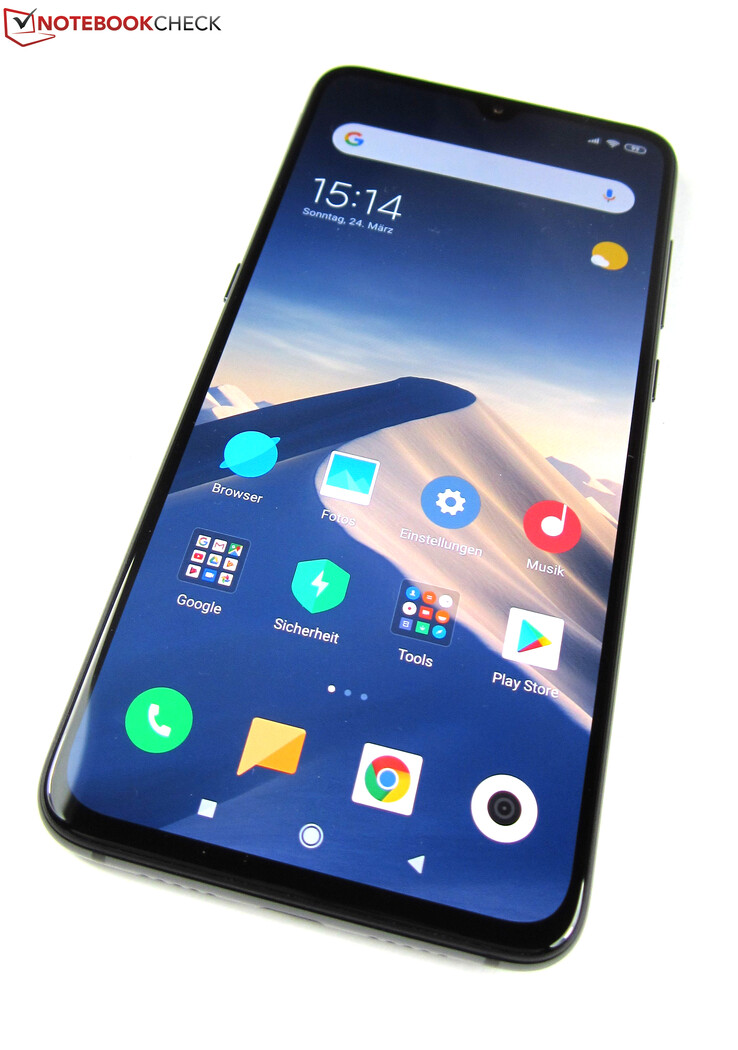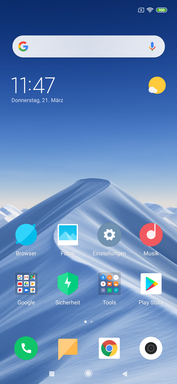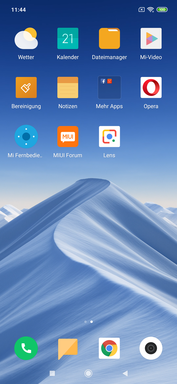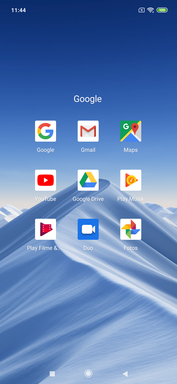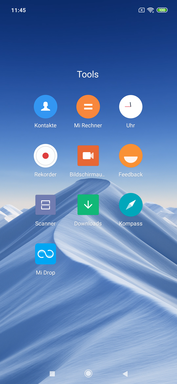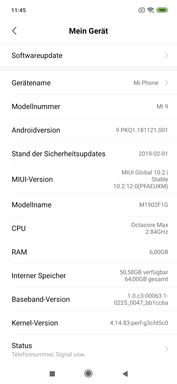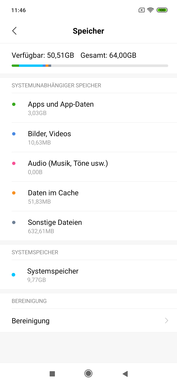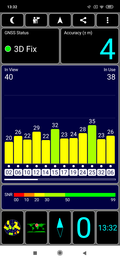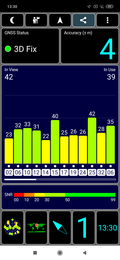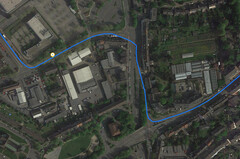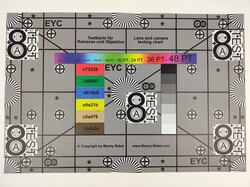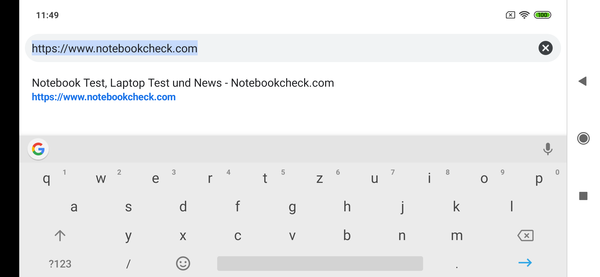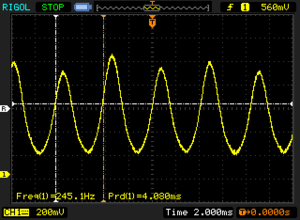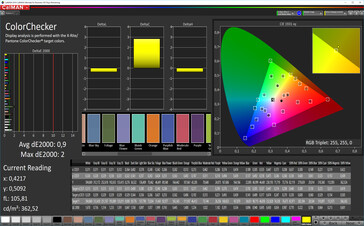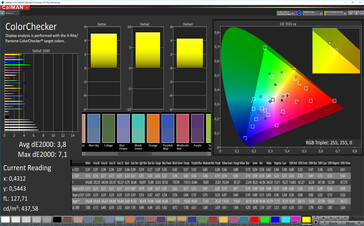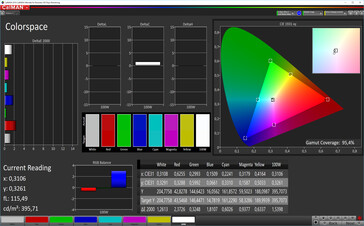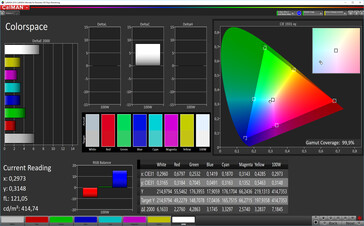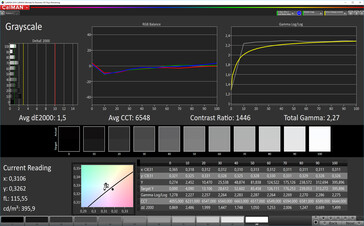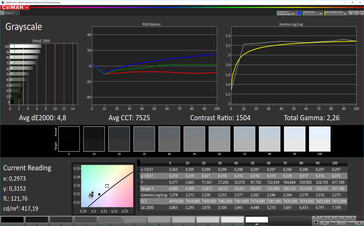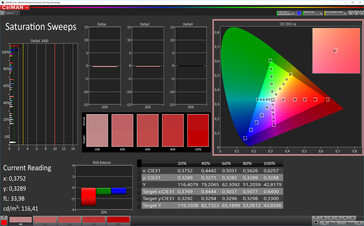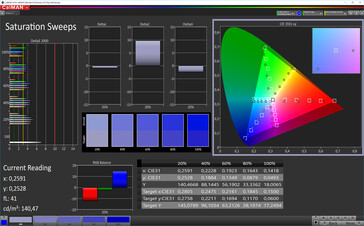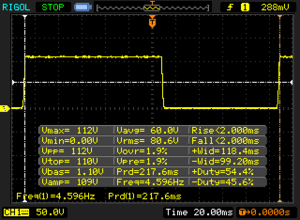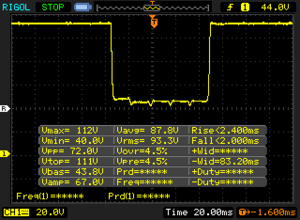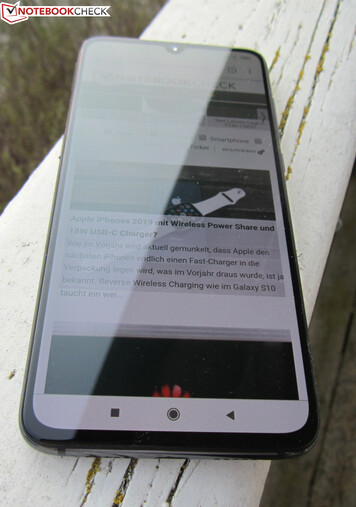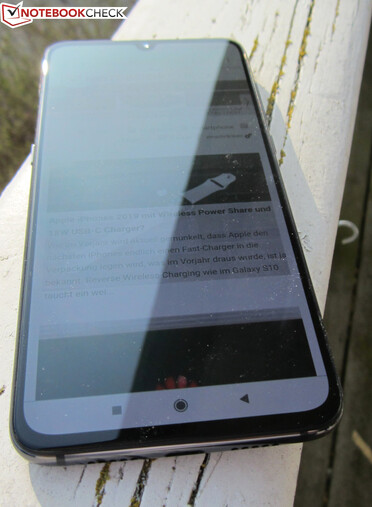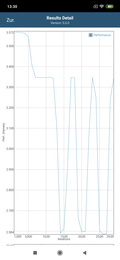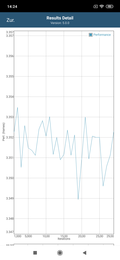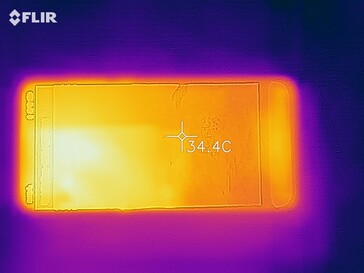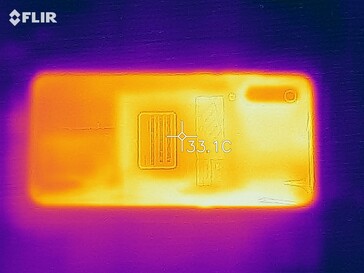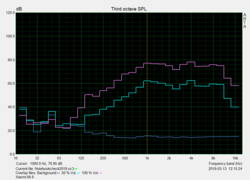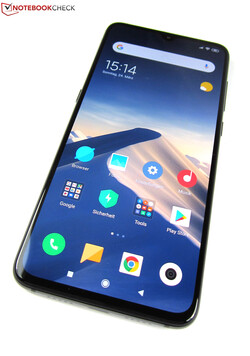Xiaomi Mi 9 Smartphone Review
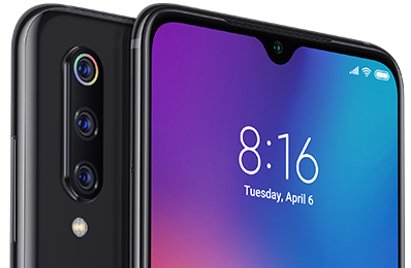
The Xiaomi Mi 9 is here, and it embarrasses its flagship competitors. Unlike Samsung, Huawei and especially Apple, the Xiaomi continues to sell its high-end smartphones at a reasonable cost and does not arbitrarily hike the price up generation upon generation.
The Mi 9 currently sells for around 450 Euros (~$505), for which you get the brand-new Qualcomm Snapdragon 855 SoC, 6 GB RAM and up to 128 GB of UFS 2.1 storage. There is a lot more to this flagship contender, but these specifications alone put the Mi 9 in contention with the considerably more expensive Huawei Mate 20 Pro and Samsung Galaxy S10+ among others. The Mi 9 premieres the Snapdragon 855 too, which is another thing that the device has over the competition.
Xiaomi sells the Mi 9 with either 64 GB or 128 GB of UFS 2.1 flash storage, the former of which comes with only 6 GB LPDDR4x RAM. By contrast, you can choose between 6 GB and 8 GB RAM if you want 128 GB of storage. The device does not support microSD card expansion though, which is a shame.
The Mi 9 also has triple rear-facing cameras with a 48 MP main sensor, a stylish glass unibody design, dual-SIM functionality and a 2340x1080 AMOLED display. Lastly, the Mi 9 supports DRM Widevine Level 1, which means that the device can stream Amazon Prime Video and Netflix in HD instead of just SD. Incidentally, the Mi 9 is the first Xiaomi smartphone to be able to do this.
We have chosen to compare the Mi 9 against some of the best flagship smartphones released in the last year. Our comparison devices will include the Apple iPhone XR, Honor View 20, Huawei Mate 20 Pro, OnePlus 6T, Samsung Galaxy S10+ and Xiaomi Mi 8.
Case
Xiaomi dresses the Mi 9, which weighs 174 g and measures 157.5 x 74.67 x 7.61 mm, in Gorilla Glass 6. This makes our review unit not only sturdy but also gives it a premium feel. It has a somewhat understated design too with its rounded corners, its narrow bezels and its waterdrop notch that contains a 20 MP front-facing camera.
Our review unit is the Piano Black version, which is the most visually unimpressive model in our opinion. If you like to make a statement with your phones, then the Ocean Blue and Lavender Violet versions are likely to be a better choice as light creates a rainbow effect when it refracts of their glass backs. We have included official press photos of those two models below, for reference. All three models have black displays and unfortunately have no IP certification against the ingress of water or dust.
While our review unit feels great in hand, it picks up fingerprints easily despite Xiaomi stressing that it has an anti-fingerprint coating. Moreover, the mostly glass design makes the Mi 9 somewhat slippery so we would recommend buying a case and a screen protector to limit the chances of damaging the device if or when it falls from your hands. Additionally, the Mi 9 sits shakily on a flat surface like a table, because its rear-facing cameras protrude by a few millimetres from its rear case.
Connectivity
As mentioned earlier, the Mi 9 comes with 6 GB RAM or 8 GB RAM along with 64 GB or 128 GB of storage. However, Xiaomi only equips the 128 GB variant with 8 GB RAM. Additionally, no model supports microSD card expansion. Moreover, our review unit, which is the 64 GB model, had only 50.5 GB of free space available upon delivery, so you may quickly run out of storage if you buy the 64 GB version.
Speaking of omissions, the Mi 9 also lacks a headphone jack, but Xiaomi includes a USB Type-C to 3.5 mm adapter in the box should you use wired headphones. The Type-C port only operates at USB 2.0 speeds though, but it does support USB On-The-Go (OTG) so you can connect external peripherals like a keyboard and mouse should you wish to do so. The Mi 9 has dual-SIM functionality too and has two nano-SIM card slots.
Software
The Mi 9 currently ships with Android 9 Pie, atop of which Xiaomi adds its MIUI 10 UI. While MIUI operates on the same concept as stock Android, Xiaomi has heavily customised it to the extent that it hardly resembles the OS that Pixel devices use in some areas.
One noticeable absentee is the app drawer, with Xiaomi choosing instead to spread app icons over several home screens like Apple does with iOS. Moreover, you swipe up from the home screen to bring up Google search rather than right as you do on stock Android; open apps are closed by swiping to the side instead of down too. Furthermore, Xiaomi has rearranged the settings menu, which may take some acclimatisation if you are used to a more stock Android experience. In short, MIUI will not feel alien to you if you have used recent versions of Android or iOS, but it has its idiosyncrasies that may catch you out initially.
Xiaomi preinstalls the standard suite of Google apps and its own along with a few third-party apps like AliExpress and Facebook. You can uninstall the latter two though, which is not always the case with some custom versions of Android. The 11 apps that Xiaomi files under the Tools folder take up approximately 280 MB of space, which is a rather small impediment on the 64 GB of storage. The Mi 9 can stream HD content from services like Amazon Prime Video and Netflix too thanks to being Widevine DRM L1-certified.
Incidentally, our review unit had February 2019 security patches installed during our tests towards the end of March. These were only one month old with Google releasing the March security patch on March 4. Hence, there should be no problems here with old and potentially compromised security patches.
Communication & GPS
The Mi 9 supports all modern Wi-Fi standards up to IEEE 802.11ac and can connect to 2.4 GHz or 5 GHz Wi-Fi networks. Xiaomi equipped the device with a 2x2 MU-MIMO router that should help it achieve excellent Wi-Fi transfer speeds. The international version that we tested also supports LTE Bands 1, 2, 3, 4, 5, 7, 8, 12, 20, 28, which is required for LTE FDD, along with Bands 38, 39 and 40 that are needed for LTE TDD. Hence, you should have no issues with connecting to an LTE network regardless of where you live. The device has an NFC chip and supports Bluetooth 5.0 too including aptX and aptX HD codecs.
The modem that Qualcomm integrates within the Snapdragon 855 SoC supports up to 2 Gb/s download speeds over LTE. However, Xiaomi has not stated what LTE speeds the Mi 9 can achieve, so we suspect that it will be lower than 2 Gb/s.
We should also point out that the Mi 9 emits comparatively high levels of radiation, which manufacturers measure in SAR, which is an acronym for specific absorption rate. The Mi 9 emits 1.389 W/kg when held against your head and 1.301 W/kg when next to the rest of your body, which is below the Federal Office for Radiation Protection (BfS) in Germany’s safe threshold of 2 W/kg. However, other manufacturers manage to significantly undercut Xiaomi here. The Galaxy S10+, for example, has an absorption rate of 0.52 W/kg. While this is not overly concerning, it is something that distinguishes the Mi 9 from other modern flagships.
As expected, our review unit achieved excellent Wi-Fi speeds in our iperf3 Client tests. The Mi 9 averaged 678 Mb/s in the download test, which we conducted with our Linksys EA8500 reference router. This speed puts the device 45 Mb/s clear of the Galaxy S10+ in second place in our comparison table. Transfer speeds fluctuated between 549 Mb/s and 725 Mb/s during this test, which is slightly more than many of our comparison devices did in the same test, although these fluctuations should be hardly noticeable in daily use.
The Mi 9 finished behind the Mate 20 Pro and iPhone XR in the upload test with an average speed of 534 Mb/s, but this is at least 11% faster than our other comparison devices. The fluctuations between 430 Mb/s and 578 Mb/s are also not as dramatic.
The Mi 9 uses BeiDou, Galileo, GLONASS, GPS, and dual-GPS for location services. The latter can also be found in some flagships like the Mate 20 Pro and helped our review unit achieve a satellite fix with up to four metres accuracy after a few seconds regardless of where we tested it. In short, the Mi 9 has excellent GPS accuracy.
We also took our review unit on a short car journey to compare its location accuracy against the Galaxy S10+. You may have seen the results from our Galaxy S10+ review, but we have included them below if you have not. The Galaxy S10+ does not support dual-GPS, yet both devices plotted roughly the same route, which makes it difficult to call a winner. The Galaxy S10+ recorded a more natural way at points, but the Mi 9 is accurate enough for all general navigation tasks like cycling, driving or walking.
Telephone Features & Call Quality
The Mi 9 supports simultaneous dual-SIM LTE and VoLTE if your mobile carrier provisions the device on its network. The MIUI phone app has a different layout than the stock Android 9 Pie, but it has all the usual features that other call apps have like a call log, contacts and quick access to phone settings too.
Our review unit has impressive call quality even over hands-free. Our call partners could easily understand us and reported that background noise did not mask our voice. Hence, the microphone does a great job at suppressing ambient noise. The Mi 9 also maintained excellent mobile network reception when connected to Vodafone despite us testing the device in a rural area.
Cameras
The days of dual rear-facing cameras being something special are definitely over. OEMs have moved towards triple or quintuple rear-facing cameras in the last year, and Xiaomi has done the same with the Mi 9. The star of the show is its 48 MP Sony IMX586 main sensor. The Chinese company has even included a dedicated 48 MP mode in its MIUI camera app, such is its attempts at delivering an excellent camera experience. Practically, the 48 MP sensor should capture even finer details than other smaller sensors can, and you should be able to enlarge photos without losing any image fidelity too.
The default camera app scales the resolution down to 12 MP for standard photos by interpolating four pixels into one, which theoretically should make pictures look more detailed. Incidentally, the IM586 has an f/1.75 aperture and a pixel size of just 0.8 μm, which helps keep it only 8 mm wide diagonally.
Xiaomi complements the 48 MP sensor with a 12 MP telephoto lens, which has an f/2.2 aperture, a 1.0 μm pixel size and a 2x optical zoom along with a 16 MP wide-angle camera that has the same aperture and pixel size. There is a 20 MP front-facing camera too. Together, these cameras offer an impressive array of options for budding photographers, which is further helped by the plethora of camera modes including a Pro mode should you want to adjust settings like ISO, shutter speed and white balance. There are other modes too like portrait, panorama and night as there are with most modern flagships.
The triple rear-facing cameras achieve exquisite results in daylight, as demonstrated below by scenes 1 and 2. Both photos have excellent dynamic range, are detailed and they look incredibly sharp too. Qualitatively, the photos shot with the Mi 9 look noticeably better upon looking closely than those shot with the Honor View 20, which uses the same 48 MP sensor. The triple cameras struggle with image noise in artificially dim lighting as with scene 3, but the result is still leaps ahead of what the View 20 manages.
The Mi 9 can record videos in numerous resolutions too ranging from Full HD at 30 FPS up to 4K UHD at 60 FPS. The default camera app has a super slow-motion mode too that records at 960 FPS. Overall, our review unit took equally impressive videos during our tests.
We also subjected our review unit to further camera tests under controlled lighting conditions. We compared its colour accuracy by comparing the colours it reproduced against our ColorChecker Passport reference chart. We also took a photo of our test chart, which sometimes catches even flagship smartphones out with its fine lines and complex structures.
The Mi 9 could not reproduce the ColorChecker Passport reference colours precisely, and generally they look oversaturated. However, the triple camera setup did a mostly great job of capturing our test chart. The coloured areas at the centre of the chart look sharp and pop against the greyscale background, while fine lines are preserved too. Contrast levels drop off noticeably towards the bottom corners of the chart, and it should not be as noticeable in most photos. In short, Xiaomi has equipped the Mi 9 with a fantastic set of cameras that challenge even the most expensive smartphones.
Accessories & Warranty
Xiaomi includes an 18 W (5 V/2.5 A, 9 V/2 A or 12 V/1.5 A) charger with the international version of the Mi 9, which supports Quick Charge 3.0. By contrast, the company includes a more powerful 27 W Quick Charge 4.0 charger with the Chinese model, for some reason. All models also come with a silicone case, a USB Type-C to USB Type-A cable, a Type-C to 3.5 mm adapter, a SIM tool, a quick-start guide, and warranty information.
Xiaomi has an extensive set of warranty pages on its website that it splits by country and region. Essentially, the company affords the Mi 9 a two-year limited warranty in countries in which it trades like Italy, Spain or the UK. By contrast, buyers based in countries where Xiaomi does not operate, like Germany, must rely on third-party warranty instead.
Please see our Guarantees, Return Policies & Warranties FAQ for country-specific information.
Input Devices & Operation
The high-quality craftsmanship of the Mi 9’s elegant glass chassis is matched by its physical buttons. The AI button, about which we will discuss more below, the power button and the volume rocker provide good feedback with their crisp pressure points and react immediately when pressed. The same applies to the AMOLED touchscreen, which detects up to 10 fingers simultaneously. Our review unit responded to inputs almost immediately with virtually no delays.
Xiaomi has also equipped the Mi 9 with an in-screen fingerprint sensor, as is the zeitgeist for 2019 flagship smartphones. The device can store up to five fingerprints and worked perfectly throughout our tests. Optionally, you can unlock the Mi 9 with your face using the front-facing camera, although this is not as secure as a fingerprint, password, pattern or PIN.
The AI button, which sits on the left-hand side of the Mi 9’s frame, triggers Google Assistant by default but you can freely customise it to open apps like the camera or other things like turning on the flashlight and switching back to your last used app. The button supports double or single presses too, and neither of them must be set to the Google Assistant unlike Samsung and its Bixby button.
Xiaomi preinstalls Google Gboard as the default keyboard for the international version of the Mi 9, which functions just as well as it does on other devices that we have tested. You can replace the keyboard with another too like those that are downloadable from the Google Play Store.
Display
The Mi 9 has a 6.9-inch AMOLED display that operates natively at 2340x1080 with a 19.5:9 aspect ratio. Xiaomi has christened this as HD+ but in practice it should not be different from other 2340x1080 displays. The display has a 403 PPI pixel density and a 90.7% screen-to-body ratio thanks to its narrow bezels.
Our review unit achieved an average maximum brightness of 586.9 cd/m², according to X-Rite i1Pro 2 and is 94% evenly lit, which is on par with the best of our comparison devices. The HDR-capable display moves with the likes of the Mate 20 Pro and the Galaxy S10+, which currently have some of the best displays found in any flagship smartphone. The more realistic APL50 test, which measures maximum luminosity by evenly distributing light and dark areas across the display, claims our review unit reaches an average maximum brightness of 714 cd/m², although this is only with the ambient light sensor activated. Switching off the sensor reduces the maximum brightness to 399 cd/m², which is only around 10% darker than the best that the OnePlus 6T and Xiaomi Mi 8 manage. The panel in our review unit also reached a minimum of 2.28 cd/m² in our tests, which should be dim enough to use the Mi 9 in a dark room without suffering from eye strain or headaches.
The only drawback with the Mi 9’s display that we noticed is that it uses pulse-width modulation (PWM) to regulate luminosity, which can cause eye problems and other issues for some people. The screen in our review unit flickers at 245.1 Hz at 99% brightness and below, which is low enough to affect those who are PWM sensitive.
| |||||||||||||||||||||||||
Brightness Distribution: 94 %
Center on Battery: 593 cd/m²
Contrast: ∞:1 (Black: 0 cd/m²)
ΔE ColorChecker Calman: 0.9 | ∀{0.5-29.43 Ø4.77}
ΔE Greyscale Calman: 1.5 | ∀{0.09-98 Ø5}
95.4% sRGB (Calman 2D)
Gamma: 2.27
CCT: 6548 K
| Xiaomi Mi 9 AMOLED, 2340x1080, 6.4" | Apple iPhone XR IPS, 1792x828, 6.1" | Huawei Mate 20 Pro OLED, 3120x1440, 6.3" | Honor View 20 LTPS, 2310x1080, 6.4" | OnePlus 6T Optic AMOLED, 2340x1080, 6.4" | Samsung Galaxy S10 Plus OLED, 3040x1440, 6.4" | Xiaomi Mi 8 AMOLED, 2248x1080, 6.2" | |
|---|---|---|---|---|---|---|---|
| Screen | -18% | -22% | -79% | -58% | -113% | -157% | |
| Brightness middle (cd/m²) | 593 | 672 13% | 576 -3% | 492 -17% | 437 -26% | 710 20% | 430 -27% |
| Brightness (cd/m²) | 587 | 641 9% | 582 -1% | 475 -19% | 442 -25% | 721 23% | 434 -26% |
| Brightness Distribution (%) | 94 | 92 -2% | 90 -4% | 94 0% | 95 1% | 97 3% | 94 0% |
| Black Level * (cd/m²) | 0.35 | 0.4 | |||||
| Colorchecker dE 2000 * | 0.9 | 1.3 -44% | 1.3 -44% | 2.4 -167% | 2.21 -146% | 3.7 -311% | 5.09 -466% |
| Colorchecker dE 2000 max. * | 2 | 2.7 -35% | 3.5 -75% | 5.2 -160% | 4.27 -114% | 10.3 -415% | 8.05 -303% |
| Greyscale dE 2000 * | 1.5 | 2.2 -47% | 1.6 -7% | 3.2 -113% | 2.1 -40% | 1.5 -0% | 3.3 -120% |
| Gamma | 2.27 97% | 2.3 96% | 2.18 101% | 2.06 107% | 2.307 95% | 2.1 105% | 2.257 97% |
| CCT | 6548 99% | 6868 95% | 6561 99% | 7125 91% | 6353 102% | 6611 98% | 7026 93% |
| Contrast (:1) | 1920 | 1230 |
* ... smaller is better
Screen Flickering / PWM (Pulse-Width Modulation)
| Screen flickering / PWM detected | 245.1 Hz | ≤ 99 % brightness setting | |
The display backlight flickers at 245.1 Hz (worst case, e.g., utilizing PWM) Flickering detected at a brightness setting of 99 % and below. There should be no flickering or PWM above this brightness setting. The frequency of 245.1 Hz is relatively low, so sensitive users will likely notice flickering and experience eyestrain at the stated brightness setting and below. In comparison: 53 % of all tested devices do not use PWM to dim the display. If PWM was detected, an average of 8083 (minimum: 5 - maximum: 343500) Hz was measured. | |||
AMOLED panels typically can produce absolute blacks because they can switch off pixels individually, and the one in the Mi 9 is no different. Blacks look rich and help the display achieve a theoretically infinite contrast ratio, which makes colours look sharp. Xiaomi has included two contrast modes too, which it has labelled “standard” and “increased contrast” within the main settings menu.
The display reproduces colours accurately when set to either mode, although colours are a bit too cool for our liking on the increased contrast mode. Our photo spectrometer and CalMAN software demonstrate that our review delivers an almost perfect colour temperature of 6,548 K, which is just 48 K above our ideal value when set to the standard contrast mode. Moreover, DeltaE deviations are all better than the ideal value of 3. None of our comparison devices can match the Mi 9 on colour accuracy. Many come close but they all fall short in one area. Hats off to Xiaomi here because it has done an exemplary job at calibrating the display in our review unit.
Display Response Times
| ↔ Response Time Black to White | ||
|---|---|---|
| 4 ms ... rise ↗ and fall ↘ combined | ↗ 2 ms rise | |
| ↘ 2 ms fall | ||
| The screen shows very fast response rates in our tests and should be very well suited for fast-paced gaming. In comparison, all tested devices range from 0.1 (minimum) to 240 (maximum) ms. » 15 % of all devices are better. This means that the measured response time is better than the average of all tested devices (20.2 ms). | ||
| ↔ Response Time 50% Grey to 80% Grey | ||
| 4.4 ms ... rise ↗ and fall ↘ combined | ↗ 2.4 ms rise | |
| ↘ 2 ms fall | ||
| The screen shows very fast response rates in our tests and should be very well suited for fast-paced gaming. In comparison, all tested devices range from 0.165 (minimum) to 636 (maximum) ms. » 15 % of all devices are better. This means that the measured response time is better than the average of all tested devices (31.6 ms). | ||
The Mi 9 is well prepared for outdoor use too thanks to its incredibly bright display. You should be able to read the device in direct sunlight, although reflections may cause you to have to look harder at the screen than if you moved to a shadier spot.
Likewise, our review unit has stable viewing angles thanks to its AMOLED panel, as we expected. We noticed a slight brightness shift when looking at the display from the side, but this does not come at the expense of readability. In short, you should have no issues with reading the Mi 9 from practically any angle.
Performance
The Mi 9 is powered by the hotly anticipated Qualcomm Snapdragon 855 SoC, which makes its first appearance in our offices. The SoC is manufactured on a 7 nm FinFET process like the HiSilicon Kirin 980 and has a Qualcomm Kyro 485 CPU that consists of a prime core that can clock up to 2.84 GHz, which is supported by three 2.42 GHz performance cores and four ARM Cortex-A55 cores that can reach 1.8 GHz combined. The SoC also integrates a Qualcomm Adreno 640 GPU. Interestingly, manufacturers can integrate the Snapdragon 855 with a 5G modem, so we expect to find it in several 5G smartphones by the end of the year.
As expected, the Mi 9 proves to be a worthy competitor to other flagship smartphones in synthetic benchmarks and completely outclassed its predecessor in the process.
When it comes to pure CPU performance, such as in Geekbench 4 Single Core and Multi-Core, the Mi 9 falls into line with its Android competitors but is resoundingly beaten by the iPhone XR and its Apple A12 Bionic SoC. However, the Adreno 640 represents a big leap over the Adreno 630 and generally outscores the ARM Mali-G76 MP10 and MP12 in synthetic GPU benchmarks like 3DMark, AnTuTu and GFXBench. The Mi 9, for example, scored around 12% more in AnTuTu v7 than the European variant of the Galaxy S10+ and 25% more than the Mate 20 Pro. Please keep in mind that the US variant of the Galaxy S10+ will not suffer the same performance deficit as our review unit though because it too is equipped with a Snapdragon 855 SoC.
| PCMark for Android | |
| Work performance score (sort by value) | |
| Xiaomi Mi 9 | |
| Huawei Mate 20 Pro | |
| Honor View 20 | |
| OnePlus 6T | |
| Samsung Galaxy S10 Plus | |
| Xiaomi Mi 8 | |
| Average Qualcomm Snapdragon 855 (10330 - 14439, n=19) | |
| Work 2.0 performance score (sort by value) | |
| Xiaomi Mi 9 | |
| Huawei Mate 20 Pro | |
| Honor View 20 | |
| OnePlus 6T | |
| Samsung Galaxy S10 Plus | |
| Xiaomi Mi 8 | |
| Average Qualcomm Snapdragon 855 (8342 - 11440, n=19) | |
| Basemark GPU 1.1 | |
| 1920x1080 Vulkan Medium Offscreen (sort by value) | |
| Xiaomi Mi 9 | |
| Huawei Mate 20 Pro | |
| OnePlus 6T | |
| Samsung Galaxy S10 Plus | |
| Average Qualcomm Snapdragon 855 (24.5 - 36.3, n=3) | |
| Vulkan Medium Native (sort by value) | |
| Xiaomi Mi 9 | |
| Huawei Mate 20 Pro | |
| OnePlus 6T | |
| Samsung Galaxy S10 Plus | |
| Average Qualcomm Snapdragon 855 (22.7 - 32.2, n=2) | |
| 1920x1080 OpenGL Medium Offscreen (sort by value) | |
| Xiaomi Mi 9 | |
| Huawei Mate 20 Pro | |
| OnePlus 6T | |
| Samsung Galaxy S10 Plus | |
| Average Qualcomm Snapdragon 855 (33.1 - 37.4, n=3) | |
| AnTuTu v7 - Total Score (sort by value) | |
| Xiaomi Mi 9 | |
| Huawei Mate 20 Pro | |
| Honor View 20 | |
| OnePlus 6T | |
| Samsung Galaxy S10 Plus | |
| Average Qualcomm Snapdragon 855 (217967 - 398720, n=16) | |
| AnTuTu v6 - Total Score (sort by value) | |
| Xiaomi Mi 9 | |
| Huawei Mate 20 Pro | |
| Honor View 20 | |
| OnePlus 6T | |
| Samsung Galaxy S10 Plus | |
| Xiaomi Mi 8 | |
| Average Qualcomm Snapdragon 855 (239512 - 268271, n=12) | |
| VRMark - Amber Room (sort by value) | |
| Xiaomi Mi 9 | |
| Huawei Mate 20 Pro | |
| OnePlus 6T | |
| Samsung Galaxy S10 Plus | |
| Average Qualcomm Snapdragon 855 (4486 - 4969, n=3) | |
| Basemark ES 3.1 / Metal - offscreen Overall Score (sort by value) | |
| Xiaomi Mi 9 | |
| Apple iPhone XR | |
| Huawei Mate 20 Pro | |
| OnePlus 6T | |
| Samsung Galaxy S10 Plus | |
| Average Qualcomm Snapdragon 855 (1075 - 1425, n=4) | |
| Average of class Smartphone (205 - 7731, n=34, last 2 years) | |
The Mi 9 is also currently one of the fastest smartphones in browser benchmarks as our comparison tables below demonstrate. Our review unit cannot shake the iPhone XR from its pinnacle, but it typically finished above or on par with our most competitive Android comparison devices.
| JetStream 1.1 - Total Score | |
| Apple iPhone XR (Safari Mobile 12.0) | |
| Xiaomi Mi 9 (Chrome 73.0.3683.75) | |
| Huawei Mate 20 Pro (Chrome 69) | |
| Average Qualcomm Snapdragon 855 (84.4 - 120, n=17) | |
| Honor View 20 (Chrome 71) | |
| Samsung Galaxy S10 Plus (Samsung Browser 9.0) | |
| OnePlus 6T (Chrome 70) | |
| Xiaomi Mi 8 (Chrome 72) | |
| Octane V2 - Total Score | |
| Average of class Smartphone (2228 - 126661, n=195, last 2 years) | |
| Apple iPhone XR (Safari Mobile 12.0) | |
| Xiaomi Mi 9 (Chrome 73.0.3683.75) | |
| Average Qualcomm Snapdragon 855 (17011 - 33918, n=21) | |
| Huawei Mate 20 Pro (Chrome 69) | |
| Honor View 20 (Chrome 71) | |
| Samsung Galaxy S10 Plus (Samsung Browser 9.0) | |
| OnePlus 6T (Chrome 70) | |
| Xiaomi Mi 8 (Chrome 72) | |
| Mozilla Kraken 1.1 - Total | |
| Xiaomi Mi 8 (Chrome 72) | |
| OnePlus 6T (Chrome 70) | |
| Average Qualcomm Snapdragon 855 (1852 - 2611, n=19) | |
| Honor View 20 (Chrome 71) | |
| Huawei Mate 20 Pro (Chrome 69) | |
| Xiaomi Mi 9 (Chrome 73.0.3683.75) | |
| Samsung Galaxy S10 Plus (Samsung Browser 9.0) | |
| Average of class Smartphone (257 - 28190, n=155, last 2 years) | |
| Apple iPhone XR (Safari Mobile 12.0) | |
| WebXPRT 3 - Overall | |
| Average of class Smartphone (38 - 380, n=30, last 2 years) | |
| Apple iPhone XR (Safari Mobile 12.0) | |
| Huawei Mate 20 Pro (Chrome 69) | |
| Samsung Galaxy S10 Plus (Samsung Browser 9.0) | |
| Xiaomi Mi 9 (Chrome 73.0.3683.75) | |
| Average Qualcomm Snapdragon 855 (90 - 129, n=20) | |
| Honor View 20 (Chrome 71) | |
| Xiaomi Mi 8 (Chrome 72) | |
| WebXPRT 2015 - Overall | |
| Apple iPhone XR (Safari Mobile 12.0) | |
| Huawei Mate 20 Pro (Chrome 69) | |
| Samsung Galaxy S10 Plus (Samsung Browser 9.0) | |
| Average Qualcomm Snapdragon 855 (260 - 316, n=2) | |
| Honor View 20 (Chrome 71) | |
| OnePlus 6T (Chrome 70) | |
| Xiaomi Mi 8 (Chrome 72) | |
| Xiaomi Mi 9 | |
* ... smaller is better
Xiaomi equips the Mi 9 with UFS 2.1 flash storage as we mentioned at the start of this article, which helps the device power through all daily tasks. We experienced practically no load times with our review unit, while apps installed almost instantly from the Google Play Store. Likewise, we could not faze the Mi 9 even with intense multitasking. In short, you should never experience any lags or stutters with the Mi 9.
AndroBench results reinforced our initial impressions too. Our review unit achieved up to 165 MB/s 4K transfer speeds, which puts it in the same league as the Mate 20 Pro and View 20. However, it only reached 666 MB/s in 256 KB sequential read tests, which is generally well below our comparison devices. However, this is almost irrelevant to everyday use, as we experienced when we opened multiple apps consecutively.
| Xiaomi Mi 9 | Huawei Mate 20 Pro | Honor View 20 | OnePlus 6T | Samsung Galaxy S10 Plus | Xiaomi Mi 8 | Average 64 GB UFS 2.1 Flash | Average of class Smartphone | |
|---|---|---|---|---|---|---|---|---|
| AndroBench 3-5 | -5% | -3% | -33% | -28% | -35% | -24% | 208% | |
| Sequential Read 256KB (MB/s) | 666 | 853 28% | 847 27% | 735 10% | 811 22% | 693 4% | 696 ? 5% | 2248 ? 238% |
| Sequential Write 256KB (MB/s) | 388.3 | 196.4 -49% | 250.1 -36% | 204.4 -47% | 249.1 -36% | 207.8 -46% | 224 ? -42% | 1887 ? 386% |
| Random Read 4KB (MB/s) | 149.4 | 157.4 5% | 168.9 13% | 138.5 -7% | 135.2 -10% | 136.3 -9% | 137.2 ? -8% | 299 ? 100% |
| Random Write 4KB (MB/s) | 165.3 | 157.8 -5% | 138.9 -16% | 22 -87% | 22.7 -86% | 21 -87% | 84.7 ? -49% | 346 ? 109% |
| Sequential Read 256KB SDCard (MB/s) | 83.2 ? | 73 ? | 68.6 ? | |||||
| Sequential Write 256KB SDCard (MB/s) | 72.4 ? | 60.7 ? | 52.2 ? |
Games
The powerful Adreno 640 GPU also makes the Mi 9 ideal for playing games. The Adreno 640 is also the first GPU to support the Vulkan 1.1 API, which we expect games to take advantage of in the coming years. Hence, the Mi 9 should remain future-proofed for at least a few years. Subjectively, even the most complex of modern games run smoothly on our review unit, regardless of the graphics settings at which they are played.
Unfortunately, we were unable to assess frame rates because the app that we usually use, GameBench, would not work on the Mi 9 at the time of testing. We hope to bring you updated benchmark results subsequently though.
Emissions
Temperature
The Mi 9 feels cool to the touch even when operating under full load, which is impressive. Surface temperatures on our review unit reached a maximum of 31.8 °C even during stress tests like GFXBench, but the device should typically average around 27 °C when idling.
However, the Mi 9 throttles from time to time to keep temperatures down, as demonstrated by GFXBench Manhattan benchmark results. Nevertheless, our review unit still scores highly even when it throttles, so we doubt that most people would notice the difference even if they push their Mi 9 hard during a long gaming session.
(+) The maximum temperature on the upper side is 31.8 °C / 89 F, compared to the average of 35.2 °C / 95 F, ranging from 21.9 to 247 °C for the class Smartphone.
(+) The bottom heats up to a maximum of 30.9 °C / 88 F, compared to the average of 34 °C / 93 F
(+) In idle usage, the average temperature for the upper side is 27.9 °C / 82 F, compared to the device average of 32.9 °C / 91 F.
Speakers
The Mi 9 has a single speaker that Xiaomi has placed on the underside of the device next to the Type-C port. The speaker sits behind the right-hand grille if the display is facing upwards; it appears that the left-hand grille is just there for decoration.
The mono speaker reached a maximum of 87.1 dB(A) during our tests, during which it did not distort. The speaker reproduces mid and high tones linearly, but bass tones are rather thin on the ground. In short, the speaker is good enough for making hands-free calls and for occasionally having music playing in the background, but we would recommend using external speakers or headphones for a better listening experience.
Xiaomi Mi 9 audio analysis
(+) | speakers can play relatively loud (87.1 dB)
Bass 100 - 315 Hz
(-) | nearly no bass - on average 25.1% lower than median
(±) | linearity of bass is average (10.7% delta to prev. frequency)
Mids 400 - 2000 Hz
(+) | balanced mids - only 4.4% away from median
(+) | mids are linear (5% delta to prev. frequency)
Highs 2 - 16 kHz
(+) | balanced highs - only 3.4% away from median
(+) | highs are linear (4% delta to prev. frequency)
Overall 100 - 16.000 Hz
(±) | linearity of overall sound is average (17.3% difference to median)
Compared to same class
» 11% of all tested devices in this class were better, 8% similar, 81% worse
» The best had a delta of 11%, average was 35%, worst was 134%
Compared to all devices tested
» 32% of all tested devices were better, 8% similar, 60% worse
» The best had a delta of 4%, average was 24%, worst was 134%
Xiaomi Mi 8 audio analysis
(±) | speaker loudness is average but good (81.2 dB)
Bass 100 - 315 Hz
(-) | nearly no bass - on average 64.6% lower than median
(+) | bass is linear (0% delta to prev. frequency)
Mids 400 - 2000 Hz
(-) | nearly no mids - on average 64.6% lower than median
(+) | mids are linear (0% delta to prev. frequency)
Highs 2 - 16 kHz
(-) | nearly no highs - on average 64.6% lower than median
(+) | highs are linear (0% delta to prev. frequency)
Overall 100 - 16.000 Hz
(-) | overall sound is not linear (124.5% difference to median)
Compared to same class
» 94% of all tested devices in this class were better, 5% similar, 1% worse
» The best had a delta of 11%, average was 35%, worst was 134%
Compared to all devices tested
» 98% of all tested devices were better, 2% similar, 0% worse
» The best had a delta of 4%, average was 24%, worst was 134%
Battery Life
Power Consumption
As we have mentioned throughout this review, the Mi 9 is the first Snapdragon 855-powered smartphone that we have tested. Hence, our power consumption table looks more skewed in the Mi 9’s favour than it will do in a few months once we have tested more Snapdragon 855-powered devices.
Regardless, the Mi 9 consumes considerably less on average than our comparison devices. Our review unit consumes a minimum of 0.67 W at idle, which is better than all but the iPhone XR of our comparison devices. Likewise, the Mi 9 averages just 1.26 W at idle, a value that is only beaten by the OnePlus 6T. The system consumed a maximum of 9.3 W under load but averages 3.71 W, which is significantly lower than our comparison devices.
In short, the Mi 9 currently has class-leading power consumption. However, we expect this to change once we have tested more Snapdragon 855-powered devices.
| Off / Standby | |
| Idle | |
| Load |
|
Key:
min: | |
| Xiaomi Mi 9 3300 mAh | Apple iPhone XR 2942 mAh | Huawei Mate 20 Pro 4200 mAh | Honor View 20 4000 mAh | OnePlus 6T 3700 mAh | Samsung Galaxy S10 Plus 4100 mAh | Xiaomi Mi 8 3400 mAh | Average Qualcomm Snapdragon 855 | Average of class Smartphone | |
|---|---|---|---|---|---|---|---|---|---|
| Power Consumption | -38% | -35% | -58% | -11% | -30% | -76% | -24% | -35% | |
| Idle Minimum * (Watt) | 0.67 | 0.61 9% | 0.95 -42% | 0.97 -45% | 0.7 -4% | 0.73 -9% | 1.5 -124% | 0.939 ? -40% | 0.847 ? -26% |
| Idle Average * (Watt) | 1.26 | 2.67 -112% | 2.17 -72% | 2.58 -105% | 1.1 13% | 1.53 -21% | 2.2 -75% | 1.506 ? -20% | 1.446 ? -15% |
| Idle Maximum * (Watt) | 1.29 | 2.69 -109% | 2.25 -74% | 2.63 -104% | 2.1 -63% | 2.07 -60% | 2.6 -102% | 1.799 ? -39% | 1.63 ? -26% |
| Load Average * (Watt) | 3.71 | 4.34 -17% | 4.47 -20% | 5.24 -41% | 4.2 -13% | 6.03 -63% | 6.1 -64% | 4.61 ? -24% | 6.95 ? -87% |
| Load Maximum * (Watt) | 9.3 | 5.66 39% | 6.15 34% | 8.73 6% | 8.3 11% | 9.18 1% | 10.9 -17% | 9.04 ? 3% | 11.3 ? -22% |
* ... smaller is better
Battery Life
The Mi 9 has a 3,300 mAh battery, which is rather small compared to the batteries in most of our comparison devices. Correspondingly, while our review unit achieved respectable runtimes in our battery life tests, it averages significantly less than all but the Galaxy S10+ of our comparison devices.
Our review unit managed almost 17 hours in our looped H.264 video battery life test, which is longer than all but the iPhone XR, which incidentally has the smallest battery life of our comparison devices. However, the Mi 9 needed recharging in under 10 hours when we ran our practical Wi-Fi test, which is over 7 hours shorter than the Honor View 20 lasted. Moreover, our review unit lasted just over 3 hours under sustained load, which is worse than all but the Galaxy S10+ of our comparison devices.
The Mi 9 supports up to 27 W wired charging, but the international version comes with an 18 W charger as we mentioned in the Accessories & Warranty section. However, our review unit still recharges fully with the included charger in 1:13 hours, which is incredibly fast. The Mi 9 can also recharge wirelessly at 20 W and is the first smartphone to be able to do so according to Xiaomi. Overall, the Mi 9 may not have the best battery life, but at least you can recharge it quickly.
| Xiaomi Mi 9 3300 mAh | Apple iPhone XR 2942 mAh | Huawei Mate 20 Pro 4200 mAh | Honor View 20 4000 mAh | OnePlus 6T 3700 mAh | Samsung Galaxy S10 Plus 4100 mAh | Xiaomi Mi 8 3400 mAh | |
|---|---|---|---|---|---|---|---|
| Battery runtime | 47% | 20% | 26% | 26% | -7% | 9% | |
| Reader / Idle (h) | 27.5 | 49.5 80% | 29.1 6% | 32.1 17% | 32.3 17% | 26 -5% | 27.2 -1% |
| H.264 (h) | 16.8 | 16.9 1% | 14.2 -15% | 15.5 -8% | 15.1 -10% | 15.4 -8% | 15 -11% |
| WiFi v1.3 (h) | 9.1 | 15.2 67% | 12.8 41% | 16.2 78% | 14.4 58% | 8.1 -11% | 12.3 35% |
| Load (h) | 3.2 | 4.5 41% | 4.7 47% | 3.7 16% | 4.4 38% | 3.1 -3% | 3.6 13% |
Pros
Cons
Verdict
The Xiaomi Mi 9 is a triumphant smartphone that puts other flagships to shame by being incredible value for money. The base model, which has 6 GB RAM and 64 GB of storage, is well-equipped by modern flagship standards. However, the 128 GB model may be a better choice for many people because the Mi 9 does not support expandable storage.
Xiaomi has equipped all Mi 9 models with excellent triple rear-facing cameras and a bright AMOLED screen that has exemplary colour accuracy, which all fits in a stylish and high-quality glass case. The new Qualcomm Snapdragon 855 SoC also makes the Mi 9 one of the most powerful smartphones that money can currently buy. That will change with the release of more Snapdragon 855-powered smartphones though.
The Xiaomi Mi 9 is the smartphone to buy if you are after a flagship experience but on a budget. It offers everything that its competitors do but without needing to spend a fortune.
While we have a few gripes, like the lack of a headphone jack and no microSD card support, the Mi 9 is in good company with many of its competitors that also lack these features. The classy glass case is also prone to fingerprints, and the triple rear-facing camera housing makes the device wobble on a table, but these quibbles do not detract from what is one of the best flagship smartphone experiences that money can buy in early 2019.
Xiaomi Mi 9
- 08/31/2022 v7 (old)
Manuel Masiero


